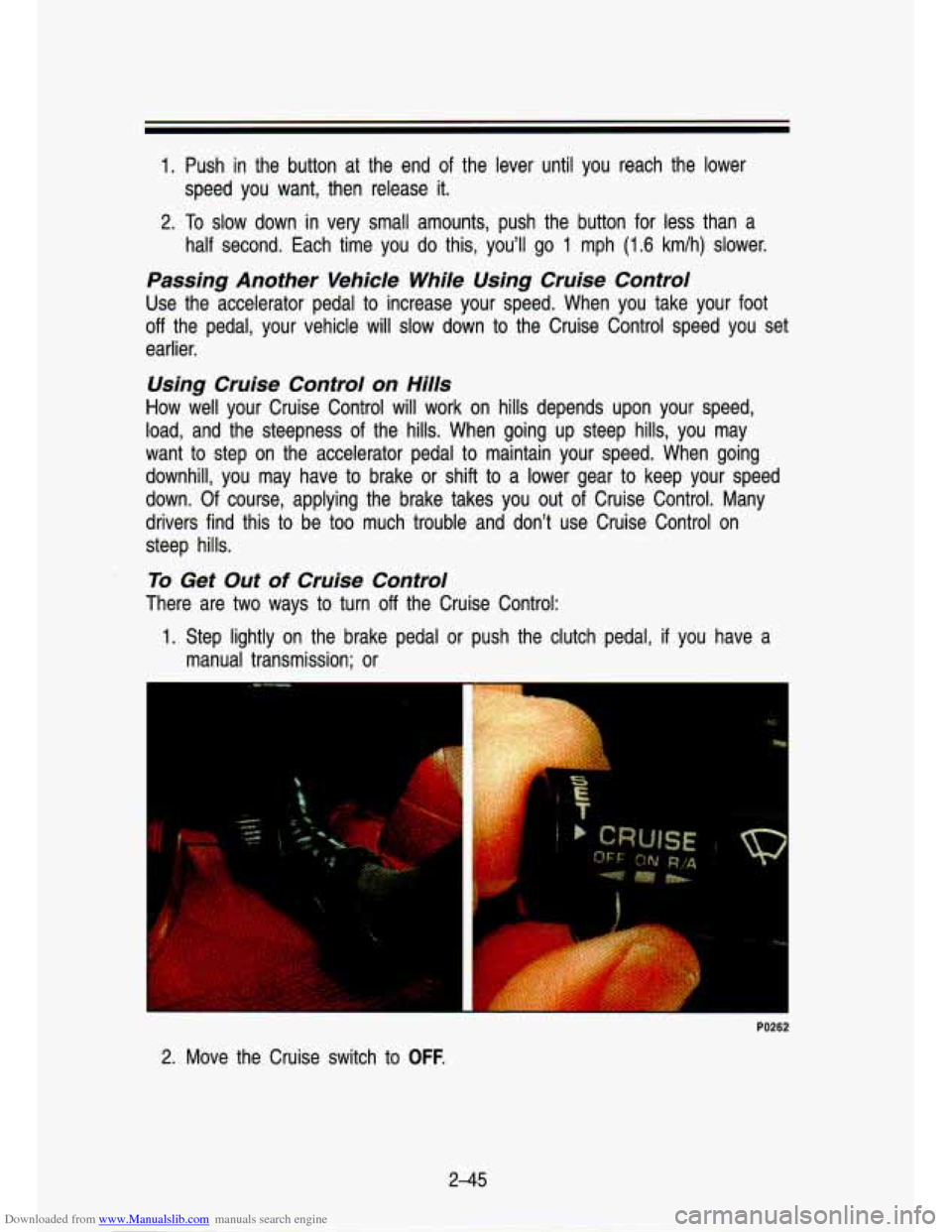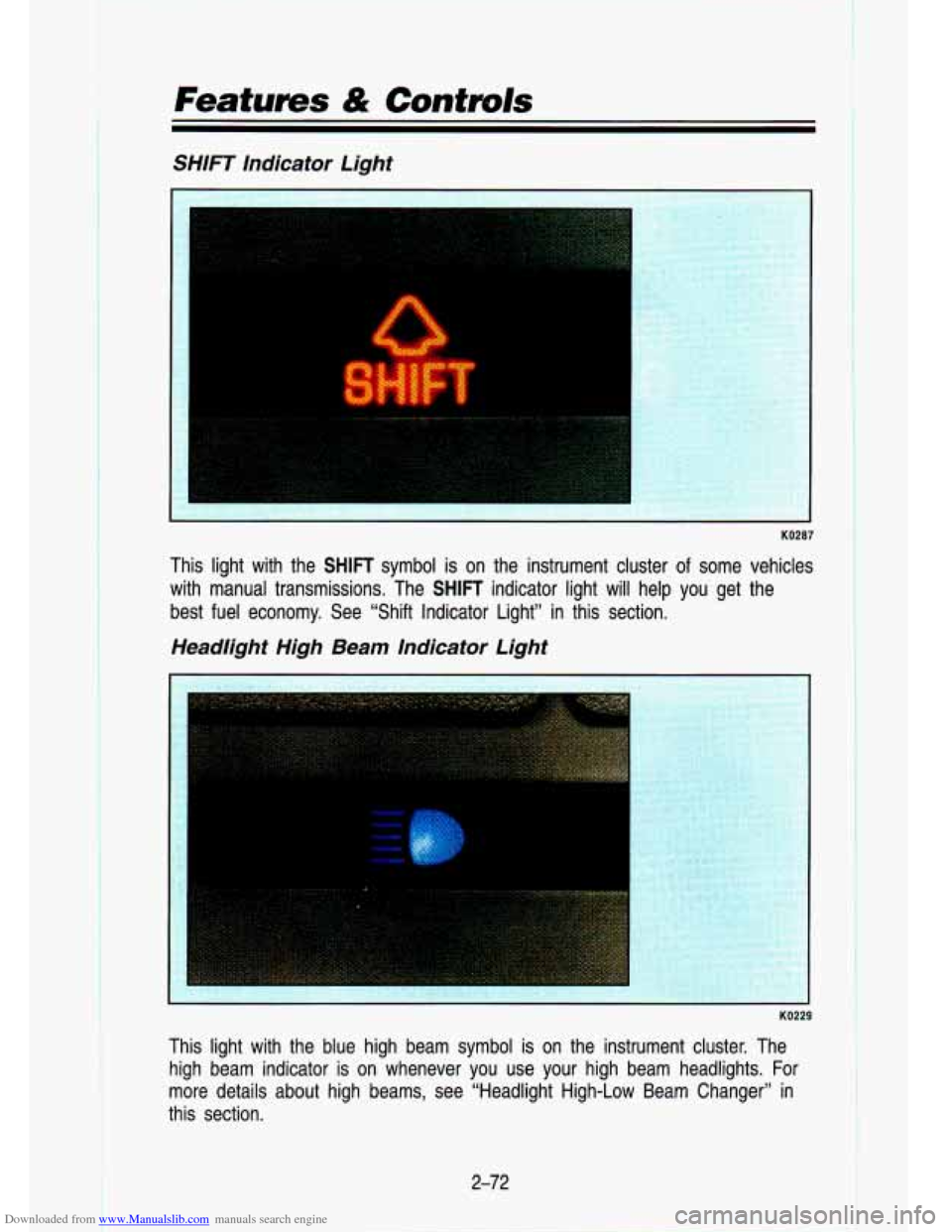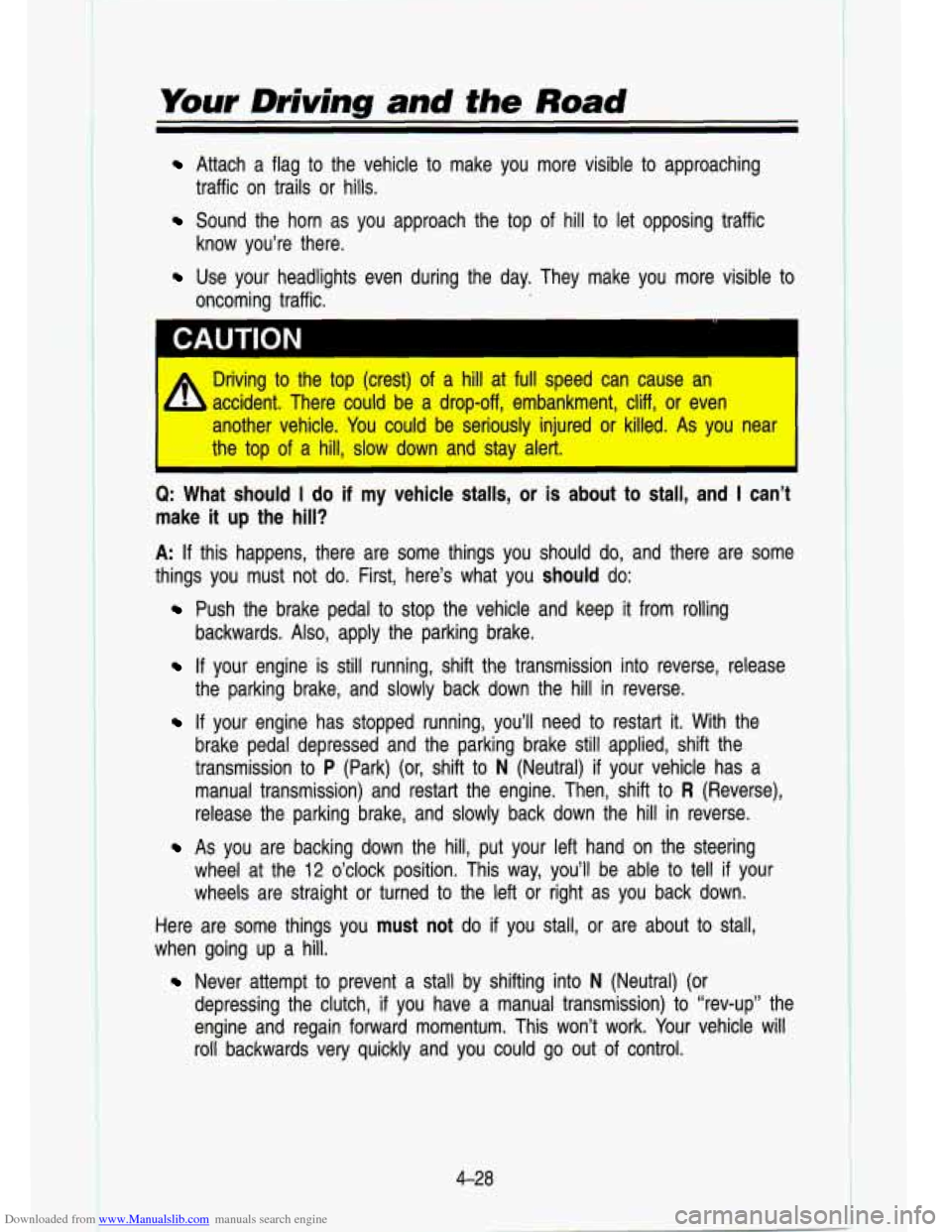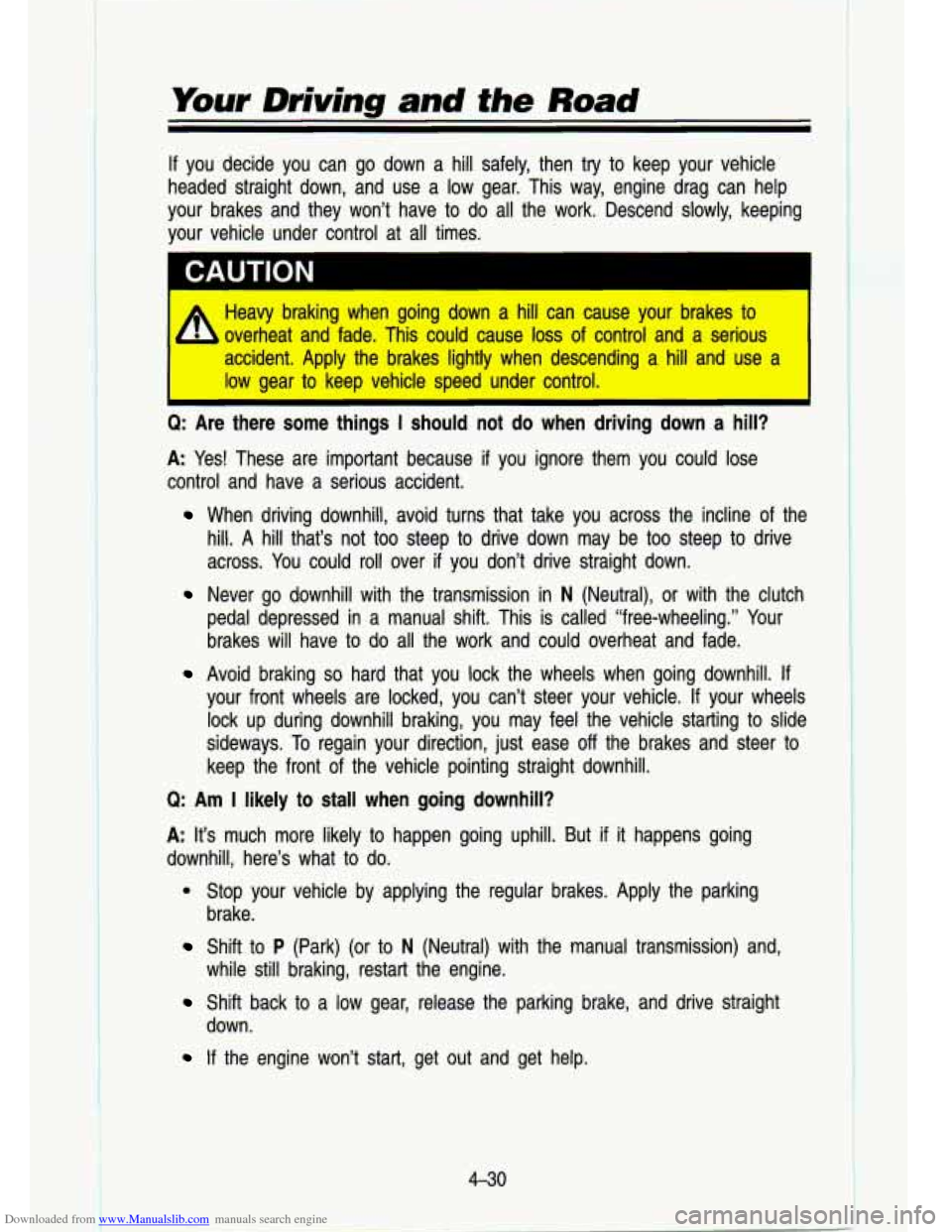1993 CHEVROLET S10 transmission
[x] Cancel search: transmissionPage 83 of 356

Downloaded from www.Manualslib.com manuals search engine To shift from 4LO to 4HI: Stop your vehicle. Shift your transmission into N
(Neutral) or depress your clutch pedal. Press and release the\
4HI switch. You
must wait for the green 4HI indicator light to stop flashing \
and go solid green
before shifting your transmission into gear or releasing the clutch pedal.
If the 4HI switch is pressed wh’en your vehicle is in gear and/or moving, the
green 4H1 indicator light will flash for
30 seconds but not complete the shift
unless the vehicle is below
3 mph and the transmission is in N (Neutral) or
the clutch pedal depressed.
On automatic transmission equipped vehicles:
If your transfer case does not
shift into- 4HI, your transmission indicator switch may require adjustment. With
your transmission in
N (Neutral), press and release the 4HI switch. While the
green 4HI indicator light
is flashing, shift your transmission into P (Park). Wait
until the 4HI indicator light goes solid green before shifting \
your transmission
into gear. This will get you into 4HI, but you should take your vehicle \
in for
service
so normal operation can be restored.
To shift from 4LO to two-wh’eel drive, “lW0 WHEEL”: You must shift from
4LO to 4HI before shifting back into two-wheel drive.
Windows
To open your manual windows, turn the hand crank on each door to raise or
lower your side door windows.
If you have the optional power windows, the co’ntrols are on e\
ach of the side
doors.
The driver’s door has a switch for the passenger windows as\
well. Your
power windows
will only work when the ignition has been turned to Run.
231
Page 93 of 356

Downloaded from www.Manualslib.com manuals search engine I 1OTICE
Cruise Control (Option)
PO259
With Cruise Control, you can maintain a speed of about 25 mph (40 km/h) or
more without keeping your foot on the accelerator. This can re\
ally help on
long trips. Cruise Control does not work at speeds below about\
25 mph (40
kmlh).
When you apply your brakes
or push the clutch pedal, if you have a manual
transmission, the Cruise Control shuts
off.
2-4 1
Page 97 of 356

Downloaded from www.Manualslib.com manuals search engine 1. Push in the button at the end of the lever until you reach the lower
2. To slow down in very small amounts, push the button for less than a
speed you want, then release
it.
half second. Each time you do this, you’ll go 1 mph (1.6 km/h) slower.
Passing Another Vehicle While Using Cruise Control
Use the accelerator pedal
to increase your speed. When you take your foot
off the pedal, your vehicle will slow down to the Cruise Control speed you set
earlier.
Using Cruise Control on Hills
How well your Cruise Control will work on hills depends upon \
your speed,
load, and the steepness of the hills. When going up steep hills, you may
want to step on the accelerator pedal to maintain your speed. When going
downhill, you may have to brake or shift to a lower gear to keep your speed
down.
Of course, applying the brake takes you out of Cruise Control. Many
drivers find this to be too much trouble and don’t use Cruise Control on
steep hills.
To Get Out of Cruise Control
There are two ways to turn off the Cruise Control:
1. Step lightly on the brake pedal or push the clutch pedal, if you have a
manual transmission; or
ruzw
2. Move the Cruise switch to OFF.
2-45
Page 107 of 356

Downloaded from www.Manualslib.com manuals search engine Storage Compartments
PO1 58
Your vehicle may have a console compartment between the bucket seats\
. To
open it, just lift the top of the console while pressing the button on the
driver’s side.
If you have an automatic transmission, your console also includes
a handy place to hold cups.
If you have a manual transmission, your console
will have a tray.
t
KO258
To open your glove box, squeeze the buttons on either side of the keyhole
together and pull the door open.
Two cup holders are provided for your
convenience. Use your door key to lock your glove box.
2-55
Page 124 of 356

Downloaded from www.Manualslib.com manuals search engine Features & Controls
SHIFT Indicator Light
1
KO287
This light with the SHIFT symbol is on the instrument cluster of some vehicles
with manual transmissions. The
SHIFT indicator light will help you get the
best fuel economy. See “Shift Indicator Light” in this section.
Headlight High Beam Indicator Light
L
This light with the blue high beam symbol is on the instrumen\
t cluster. The
high beam indicator is on whenever you use your high beam headlights. For
more details about high beams, see “Headlight High-Low Beam \
Changer” in
this section.
2-72
Page 182 of 356

Downloaded from www.Manualslib.com manuals search engine Your Driving and the Road
Attach a flag to the vehicle to make you more visible to approaching
traffic on trails or hills.
Sound the horn as you approach the top of hill to let opposing traffic
know you’re there.
Use your headlights even during the day. They make you more v\
isible to
oncoming traffic.
* Drivilng to the top (crest) of a hill at full speed can cause an
I accident. There could be a drop-off, embankment, cliff, or even
another vehicle. You could be seriously injured or killed.
As you near
the
top of a hill, slow down and stay alert. I
Q: What should I do if my vehicle stalls, or is about to stall, and I can’t
make
it up the hill?
A: If this happens, there are some things you should do, and there are some
things you must not
do. First, here’s what you should do:
Push the brake pedal to stop the vehicle and keep it from rolling
backwards. Also, apply the parking brake.
If your engine is still running, shift the transmission into rever\
se, release
the parking brake, and slowly back down the hill in reverse.
If your engine has stopped running, you’ll need to restart it. With the
brake pedal depressed and the parking brake still applied, shift the
transmission
to P (Park) (or, shift to N (Neutral) if your vehicle has a
manual transmission) and restart the engine. Then, shift
to R (Reverse),
release the parking brake, and slowly back down the hill in reverse.
As you are backing down the hill, put your left hand on the \
steering
wheel at the
12 o’clock position. This way, you’ll be able to tell if your
wheels are straight or turned
to the left or right as you back down.
Here are some things you must not
do if you stall, or are about to stall,
when going up a hill.
Never attempt to prevent a stall by shifting into N (Neutral) (or
depressing the clutch,
if you have a manual transmission) to “rev-up” the
engine and regain forward momentum. This won’t work. Your vehicle will
roll backwards very quickly and you could go out of control.
4-28
I
Page 183 of 356

Downloaded from www.Manualslib.com manuals search engine Instead, apply the regular brake to stop the vehicle. Then apply the
parking brake. Shift into reverse, release the parking brake, a\
nd slowly
back down.
Never attempt to turn around if you are about to stall when going up a
hill. If the hill is steep enough to stall your vehicle, it’s steep enough to
cause you to roll over
if you turn around. If you can’t make it up the
hill, you must back down the hill.
Q: Suppose, after stalling, I try to back down the hill and decide I just
can’t
do it. What should I do?
A: Set the parking brake, put your transmission in P (Park) (or the manual
transmission in first gear), and turn
off the engine. Leave the vehicle and go
get some help. Exit on the uphill side and stay clear of the path the vehicle
would take
if it rolled downhill. Do not shift the transfer case to N (Neutral)
when you leave the vehicle. Leave it in some gear.
A
If you have a manual transfer case shift lever, shifting the \
transfer
case to
N (Neutral) can cause your vehicle to roll even if the
transmission is in
P (Park) (or, if you have the manual transmission,
even
if you’re in gear). This is because the N (Neutral) position on
the transfer case overrides the transmission.
If you are going to
leave your vehicle, set the parking brake and shift the transmission
to
P (Park) (or, put your manual transmission in first gear). But do
not shift the transfer case to the
N (Neutral) position. Leave the
transfer case in the
2 WHEEL, 4 HIGH or 4 LOW position.
Driving Downhill
When off-roading takes you downhill, you’ll want to consider a number of
things:
How steep is the downhill? Will I be able to maintain vehicle control?
What’s the surface like? Smooth? Rough? Slippery? Hard-packed \
dirt?
Gravel?
Are there hidden surface obstacles? Ruts? Logs? Boulders?
What’s at the bottom of the hill? Is there a hidden creek bank or even a
river bottom with large rocks?
4-29
Page 184 of 356

Downloaded from www.Manualslib.com manuals search engine Your Driving and the Road
If you decide you can go down a hill safely, then try to keep \
your vehicle
headed straight down, and use a low gear. This way, engine drag can help
your brakes and they won’t have to do all the work. Descend slowly, keeping
your vehicle under control at all times.
A
Heavy braking when going down a hill can cause your brakes to
overheat and fade. This could cause
loss of control and a serious
accident. Apply the brakes lightly when descending a hill and use a
low gear to keep vehicle speed under
1 control.
Q: Are there some things I should not do when driving down a hill?
A: Yes! These are important because
if you ignore them you could lose
control and have a serious accident.
When driving downhill, avoid turns that take you across the in\
cline of the
hill. A hill that’s not too steep to drive down may be too steep to drive
across. You could roll over
if you don’t drive straight down.
Never go downhill with the transmission in N (Neutral), or with the clutch
pedal depressed in a manual shift. This is called “free-wheeling.” Your
brakes will have to do all the work and could overheat and fade.
Avoid braking so hard that you lock the wheels when going downhill. If
your front wheels are locked, you can’t steer your vehicle. \
If your wheels
lock up during downhill braking, you may feel the vehicle starting to slide
sideways.
To regain your direction, just ease off the brakes and steer to
keep the front of the vehicle pointing straight downhill.
Q: Am I likely to stall when going downhill?
A: It’s much more likely to happen going uphill. But if it happens going
downhill, here’s what to do.
* Stop your vehicle by applying the regular brakes. Apply the parking
brake.
Shift to P (Park) (or to N (Neutral) with the manual transmission) and,
while still braking, restart the engine.
Shift back to a low gear, release the parking brake, and drive straight
down.
4-30
If the engine won’t start, get out and get help.